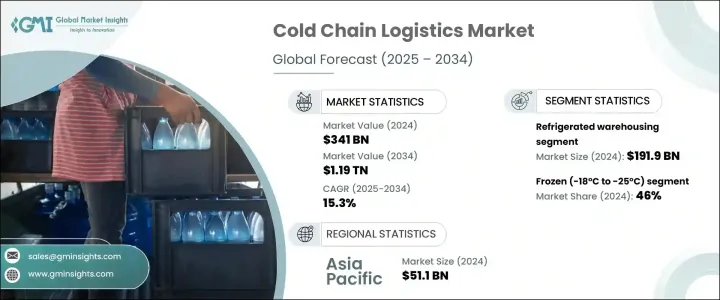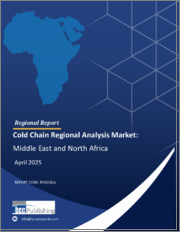
|
시장보고서
상품코드
1699258
세계의 콜드체인 물류 시장 - 기회, 성장 촉진요인, 산업 동향 분석, 예측(2025-2034년)Cold Chain Logistics Market Opportunity, Growth Drivers, Industry Trend Analysis, and Forecast 2025-2034 |
||||||
세계의 콜드체인 물류 시장은 2024년 3,410억 달러로, 2025년부터 2034년까지 15.3%의 연평균 복합 성장률(CAGR)로 성장할 것으로 예측되고 있습니다.
IoT, AI, 블록체인의 통합은 실시간 추적을 가능하게 하고, 재고와 루트를 최적화하고, 안전하고 투명한 거래를 확보함으로써 이 업계에 큰 변화를 촉구하고 있습니다. 그 결과 물류기업은 창고, 라스트마일 배송, 자동화 시스템에 많은 투자를 하고 있습니다.

서비스 경제의 중요한 축을 담당하는 냉장 창고에는 보관품의 최적 온도를 유지하기 위한 고급 냉장 시스템과 정밀한 제어가 필요합니다. 혁신적인 IT 솔루션은 냉장 창고에서 인기를 끌고 있으며, 클라우드 기반 시스템을 무인으로 기존 인프라와 원활하게 통합함으로써 비용을 절감하고 업무 효율성을 높일 수 있습니다.
| 시장 범위 | |
|---|---|
| 시작 연도 | 2024년 |
| 예측 연도 | 2025-2034년 |
| 시작 금액 | 3,410억 달러 |
| 예측 금액 | 1조 1,900억 달러 |
| CAGR | 15.3% |
온도대별로는 냉장(0-8℃), 냉동(-18--25℃), 급냉동(-25--60℃)으로 분류됩니다. 이 성장은 신선도와 안전성을 유지하기 위해 엄격한 온도 조절이 필요한 조리 된 냉동 식품, 유제품 및 고기 가공품 수요 증가가 견인하고 있습니다.
시장은 용도별로도 과일 및 야채, 유제품 및 빙과류, 베이커리 및 과자류, 식육 및 어패류, 의약품, 기타에 구분됩니다. 이로 인해 의약품의 안전성과 효능을 보장하기 위한 온도에 민감한 물류의 필요성이 크게 높아지고 있습니다.
아시아태평양은 콜드체인 물류 시장을 선도하고 있으며, 2024년 시장 점유율은 35%로 중국이 511억 달러의 수익을 올렸습니다. 급속한 경제 성장, 기술진보, 산업기반의 확대가 뒷받침되고 있습니다.
목차
제1장 조사 방법과 조사 범위
- 조사 디자인
- 조사 접근
- 데이터 수집 방법
- 기본 추정과 계산
- 기준연도의 산출
- 시장추계의 주요 동향
- 예측 모델
- 1차 조사와 검증
- 시장 정의
제2장 주요 요약
제3장 업계 인사이트
- 생태계 분석
- 공급자의 상황
- 생산자 및 제조업체
- 냉장창고업자
- 수송업자
- 기술 공급자
- 물류 통합자
- 이익률 분석
- 기술과 혁신의 전망
- 특허 분석
- 주요 뉴스 및 이니셔티브
- 규제 상황
- 영향요인
- 성장 촉진요인
- 온도에 민감한 상품에 대한 수요 증가
- 전자상거래 분야의 성장
- 냉동기술의 진보
- 세계화와 식품의 국제거래 증가
- 엄격한 식품안전규제
- 업계의 잠재적 위험 및 과제
- 콜드체인의 구축과 운영에 드는 고비용
- 온도 무결성 유지
- 성장 촉진요인
- 성장 가능성 분석
- Porter's Five Forces 분석
- PESTEL 분석
제4장 경쟁 구도
- 소개
- 기업 점유율 분석
- 경쟁 포지셔닝 매트릭스
- 전략 전망 매트릭스
제5장 시장 추계 및 예측 : 서비스별, 2021-2034년
- 주요 동향
- 냉장 창고
- 냉장 수송
- 냉장 도로 수송
- 냉장 철도 수송
- 냉장 항공 수송
- 냉장 해상 수송
제6장 시장 추계 및 예측 : 전개 모드별, 2021-2034년
- 주요 동향
- 클라우드 기반
- 온프레미스
제7장 시장 추계 및 예측 : 온도 범위별, 2021-2034년
- 주요 동향
- 냉장(0-8℃)
- 냉동(-18--25℃)
- 급냉동(-25--60℃)
제8장 시장 추계 및 예측 : 용도별, 2021-2034년
- 주요 동향
- 과일 및 야채
- 유제품 및 빙과류
- 베이커리 및 과자류
- 고기, 생선, 해산물
- 의약품
- 기타
제9장 시장 추계 및 예측 : 지역별, 2021-2034년
- 주요 동향
- 북미
- 미국
- 캐나다
- 유럽
- 영국
- 독일
- 프랑스
- 이탈리아
- 스페인
- 러시아
- 북유럽
- 아시아태평양
- 중국
- 인도
- 일본
- 한국
- 뉴질랜드
- 라틴아메리카
- 브라질
- 멕시코
- 아르헨티나
- 중동 및 아프리카
- UAE
- 사우디아라비아
- 남아프리카
제10장 기업 프로파일
- Americold Logistics
- Burris Logistics
- CH Robinson Worldwide
- CEVA Logistics
- Cold Box Express
- Conestoga Cold Storage
- Congebec Logistics
- DB Schenker
- DHL International
- Kloosterboer
- Lineage Logistics Holding
- Maersk
- NewCold Coöperatief UA
- Nichirei Logistics Group(Nichirei Corporation)
- Polar International
- Tippmann Group
- US Cold Storage
- UPS Supply Chain Solutions
- Versacold Logistics Services
- YUSEN LOGISTICS
The Global Cold Chain Logistics Market was valued at USD 341 billion in 2024 and is projected to grow at a CAGR of 15.3% between 2025 and 2034. The integration of IoT, AI, and blockchain is driving a significant transformation in this industry by enabling real-time tracking, optimizing inventory and routes, and ensuring secure, transparent transactions. The rise of e-commerce has further fueled demand for efficient logistics services, prompting businesses to strengthen their logistics networks to manage increased order volumes. As a result, logistics companies are investing heavily in warehousing, last-mile delivery, and automated systems. The refrigerated warehousing segment, which generated USD 191.9 billion in 2024, is expected to grow at a CAGR of around 15% through 2034 due to increasing demand for storage solutions that ensure temperature control for perishable goods like food, pharmaceuticals, and biotechnology products.

Refrigerated warehousing, a critical part of the service economy, involves advanced refrigeration systems and precise controls to maintain optimal temperatures for stored goods. The growth of this segment is being driven by rising demand for frozen and chilled products, coupled with the need for reliable storage solutions that prevent spoilage. Innovative IT solutions are gaining traction in refrigerated storage, where unmanned, cloud-based systems can integrate seamlessly with existing infrastructure, reducing costs and enhancing operational efficiency.
| Market Scope | |
|---|---|
| Start Year | 2024 |
| Forecast Year | 2025-2034 |
| Start Value | $341 Billion |
| Forecast Value | $1.19 Trillion |
| CAGR | 15.3% |
By temperature range, the market is categorized into chilled (0°C to 8°C), frozen (-18°C to -25°C), and deep frozen (-25°C to -60°C). In 2024, the frozen segment dominated the market with a 46% share and is expected to grow at a CAGR of over 15.5% between 2025 and 2034. This growth is driven by increasing demand for pre-cooked frozen meals, dairy products, and processed meat that require strict temperature regulation to preserve freshness and safety. Additionally, the global trade of meat and fish relies heavily on deep freezing technology to maintain quality during transport and storage.
The market is also segmented by application into fruits and vegetables, dairy and frozen desserts, bakery and confectionery, meat, fish, and seafood, pharmaceuticals, and others. The pharmaceutical segment is expected to maintain its dominance due to advancements in drug development, manufacturing, and supply chain management. The growth of biopharmaceuticals and personalized medicine has significantly increased the need for temperature-sensitive logistics to ensure the safety and efficacy of drugs. Moreover, the global distribution of vaccines has led to increased investment in cold chain systems to support pharmaceutical and healthcare supply chains effectively.
Asia-Pacific leads the cold chain logistics market, holding a 35% market share in 2024, with China generating USD 51.1 billion in revenue. The region's dominance is fueled by rapid economic growth, technological advancements, and expanding industrial bases in countries such as China, India, and Japan. Significant investments in manufacturing, infrastructure, and digital industries are further propelling the growth of cold chain logistics in the region.
Table of Contents
Chapter 1 Methodology & Scope
- 1.1 Research design
- 1.1.1 Research approach
- 1.1.2 Data collection methods
- 1.2 Base estimates and calculations
- 1.2.1 Base year calculation
- 1.2.2 Key trends for market estimates
- 1.3 Forecast model
- 1.4 Primary research & validation
- 1.4.1 Primary sources
- 1.4.2 Data mining sources
- 1.5 Market definitions
Chapter 2 Executive Summary
- 2.1 Industry 3600 synopsis, 2021 - 2034
Chapter 3 Industry Insights
- 3.1 Industry ecosystem analysis
- 3.2 Supplier landscape
- 3.2.1 Producers & manufacturers
- 3.2.2 Cold storage providers
- 3.2.3 Transportation providers
- 3.2.4 Technology providers
- 3.2.5 Logistics integrators
- 3.3 Profit margin analysis
- 3.4 Technology & innovation landscape
- 3.5 Patent analysis
- 3.6 Key news & initiatives
- 3.7 Regulatory landscape
- 3.8 Impact forces
- 3.8.1 Growth drivers
- 3.8.1.1 Increasing demand for temperature-sensitive goods
- 3.8.1.2 Growth of the e-commerce sector
- 3.8.1.3 Advancements in refrigeration technologies
- 3.8.1.4 Globalization and increasing international trade in food products
- 3.8.1.5 Stringent food safety regulations
- 3.8.2 Industry pitfalls & challenges
- 3.8.2.1 High costs of setting up and running a cold chain
- 3.8.2.2 Maintaining temperature integrity
- 3.8.1 Growth drivers
- 3.9 Growth potential analysis
- 3.10 Porter's analysis
- 3.11 PESTEL analysis
Chapter 4 Competitive Landscape, 2024
- 4.1 Introduction
- 4.2 Company market share analysis
- 4.3 Competitive positioning matrix
- 4.4 Strategic outlook matrix
Chapter 5 Market Estimates & Forecast, By Service, 2021 - 2034 ($Bn)
- 5.1 Key trends
- 5.2 Refrigerated warehousing
- 5.3 Refrigerated transportation
- 5.3.1 Refrigerated road transport
- 5.3.2 Refrigerated rail transport
- 5.3.3 Refrigerated air transport
- 5.3.4 Refrigerated sea transport
Chapter 6 Market Estimates & Forecast, By Deployment Mode, 2021 - 2034 ($Bn)
- 6.1 Key trends
- 6.2 Cloud-based
- 6.3 On-premises
Chapter 7 Market Estimates & Forecast, By Temperature Range, 2021 - 2034 ($Bn)
- 7.1 Key trends
- 7.2 Chilled (0°C to 8°C)
- 7.3 Frozen (-18°C to -25°C)
- 7.4 Deep Frozen (-25°C to -60°C)
Chapter 8 Market Estimates & Forecast, By Application, 2021 - 2034 ($Bn)
- 8.1 Key trends
- 8.2 Fruits & vegetables
- 8.3 Dairy & frozen desserts
- 8.4 Bakery & confectionery
- 8.5 Meat, fish, and seafood
- 8.6 Pharmaceuticals
- 8.7 Others
Chapter 9 Market Estimates & Forecast, By Region, 2021 - 2034 ($Bn)
- 9.1 Key trends
- 9.2 North America
- 9.2.1 U.S.
- 9.2.2 Canada
- 9.3 Europe
- 9.3.1 UK
- 9.3.2 Germany
- 9.3.3 France
- 9.3.4 Italy
- 9.3.5 Spain
- 9.3.6 Russia
- 9.3.7 Nordics
- 9.4 Asia Pacific
- 9.4.1 China
- 9.4.2 India
- 9.4.3 Japan
- 9.4.4 South Korea
- 9.4.5 ANZ
- 9.5 Latin America
- 9.5.1 Brazil
- 9.5.2 Mexico
- 9.5.3 Argentina
- 9.6 MEA
- 9.6.1 UAE
- 9.6.2 Saudi Arabia
- 9.6.3 South Africa
Chapter 10 Company Profiles
- 10.1 Americold Logistics
- 10.2 Burris Logistics
- 10.3 C.H. Robinson Worldwide
- 10.4 CEVA Logistics
- 10.5 Cold Box Express
- 10.6 Conestoga Cold Storage
- 10.7 Congebec Logistics
- 10.8 DB Schenker
- 10.9 DHL International
- 10.10 Kloosterboer
- 10.11 Lineage Logistics Holding
- 10.12 Maersk
- 10.13 NewCold Coöperatief UA
- 10.14 Nichirei Logistics Group (Nichirei Corporation)
- 10.15 Polar International
- 10.16 Tippmann Group
- 10.17 U.S. Cold Storage
- 10.18 UPS Supply Chain Solutions
- 10.19 Versacold Logistics Services
- 10.20 YUSEN LOGISTICS



















